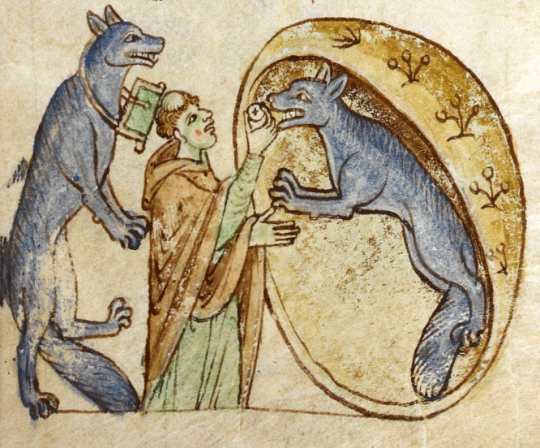Werewolves of Ossory
Here is a personal favorite story. I reference werewolf stories a lot, but I don’t actually tell them in detail very often. Well, it’s high time I went into detail about one other than just Lycaon, which is an important one but definitely not one of my favorites..
Some of this might sound pretty similar to the Arcadians and some of their stories, but here’s a fun twist…
Firstly, this story comes from Topographia Hibernica, written by Giraldus Cambrensis (c. 1146-1223), also called Gerald of Wales. To pull his little bio from page ix of Charlotte F. Otten’s A Lycanthropy Reader…
Welsh cleric, Chaplain to Henry II. He wrote voluminously, filling his histories and travel writing with legends, natural history, and lively anecdotes.
In this story, a monk was going through some woods with a group of fellow travelers. Suddenly, a large wolf appeared and beseeched the monk for help. He spoke well, was humble, and displayed excellent manners.
The monk was, of course, very freaked out, but the wolf asked him to help his companion. The monk follows him back to said companion, who turns out to be a wolf who is sick and, according to many versions, on the verge of death.

The second wolf removes her wolf form (”using his claw as a hand”), and reveals she is an old lady.
The monk is even more freaked out, but the werewolves explain that they are from Ossory, a place where they were turned into wolves as – essentially – a trial, much like in Arcadia. A man and a woman from their land takes the form of a wolf once every seven years. This was supposedly because they were descendants of an Irish warrior, Laignech Fáelad, ancestor of the kings of Ossory. He was the first of his kind to assume the shape of a wolf and go “wolfing,” and his people followed after him. So there are lots of Irish werewolves out there, and the people of Ossory are just one example – and this is only one of their stories.
Anyway, after the monk provides the old lady her last rites, the werewolves thank him, she returns to werewolf form, and the first werewolf says he will watch over the monk and his friends for the duration of the night (again: werewolves as protectors).
In the morning, they are perfectly safe, and the werewolf is still there. He tells them where to go, takes them to the road, and sends them on their way. Giraldus ends the story with a contemplation on, essentially, if people turned into animals and animal-people are intelligent and civilized, does that make them beasts or monsters? His answer is no, it does not, and to kill one would be the same as killing any other person – and that, of course, would be wrong.
There are lots of different versions of the story as a result of translations and other copies and the like, so one you find might be different from another.
Please note, however, that there is a lot of false information flying around about the werewolves of Ossory legends. Be careful what you read and always, always check your sources for good primary material, even if you have to dig through a lot of sources to find the root one! (checking for primary sources is very important, like if you still think the “Wulver” tumblr meme is an actual legend)
So what does this mean, in terms of literary examination? When we have everybody trying to tell us Christians saw werewolves as Satanic?
Well, they didn’t always. In fact, it was pretty frequently that they didn’t – especially before the Early Modern and/or Renaissance period, which is when things really started to change.
There was a valley of difference between witches and their demonic sorcery and other things – and not all witch trials should be treated as “werewolves” if the person in question just happened to turn into a wolf (case in point, Peter Stubbe). It was important to recognize the difference – and that’s a moral of the story: Don’t assume something is evil just by its form.
After all, one can’t be a good person if they would treat someone who turns into a wolf or wolf-man – or who is turned into a wolf or wolf-man – crappy just because they don’t like the way they look. Now can they? And that, of course, is a metaphor for a whole lot of other things.
So be nice to werewolves! They’re people, too, just like the rest of us.